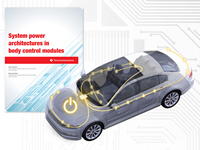Description
Functions of comfort and convenience available in all modern vehicles today (and in the foreseeable future) rely on body control modules (BCMs). BCMs work behind the scenes to operate headlights, rear lights, interior ambient lights, windshield wipers and more.
Both the quantity of BCMs in a car and the number of comfort and convenience loads that each BCM controls vary across vehicle models. From a BCM that only handles lighting functions to a BCM that includes gateway functionality and car-access support, the number of BCMs and their complexity depend on the underlying architecture of the vehicle body electronics.
BCM designs are also rapidly evolving. For example, junction boxes (also known as power distribution boxes), which distribute power to various loads using relays, are either being integrated into BCMs or converted to BCM-like modules to distribute power through semiconductor switches. More driver inputs and sensors are being connected to BCMs as the number of comfort and convenience features increases. And as the number of dedicated load-control modules (such as those for roof motor control) increases, BCM networking requirements also increase.
